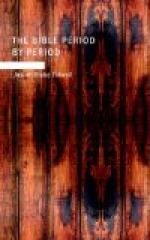Geology has also done much to confirm the flood story. Geologists are well acquainted with facts in world history that bring the flood “entirely within the range of natural phenomena.” The Scripture (Gen. 7:11) speaks of the fountains of the deep being broken, language that could refer to the inrushing of the sea upon a depression of the earth which later rose again. Such elevations and depressions have occurred many times. An example is the elevation of the coast of Chile by an earthquake in 1822. Such an explanation by no means destroys the miracle of it, since the coming just when Noah had completed the ark and entered it and just when God said it would come, provided the element of miracle. A wide-spread flood is also required by the discovery of evidence in the earth of the destruction of animal life.
Some Teachings of This Period. The teachings of this period may be divided into three groups: Those concerning Cain and Abel; those concerning Cain and Seth. or the two races; those concerning the flood.
Those concerning Cain and Abel are: (1) The mere fact of having worshiped is not a guarantee of acceptance with God. (2) Both the spirit and the form of worship must please Jehovah. (3) God tries to point out the right way to men and only punishes when man fails to give heed. (4) Man is free and though God may turn to show him a better way, he will not restrain him by force even from the worst crimes. (5) To try to shun the responsibility of being our brother’s keeper is to show the spirit of Cain.
The story of Cain and Seth, or the two races show: (1) That our acts reveal our thoughts. (2) That the indulgence of our lusts and appetites disgraces the noblest people. (3) That outward culture without true religion will not save a people. (4) The noble and good will finally dominate other men.
The story of the flood teaches: (1) That Jehovah can not make men righteous against their will. (2) That men by wickedness grieve God and thwart his purposes. (3) That man has, therefore, power to cause his own destruction. (4) That God does not save because of numbers or civilization, but because of character and obedience to his laws. (5) That God is pleased with the worship of those who obey him.
For Study and Discussion, (1) The consequences of sin as seen in this period with special reference to the new truths added to those of the former period. (2) New truths about God. (3) The beginning of the arts of civilization. (4) The unity of the race. (S) The names and ages of the six oldest men and whether any one of them could have known personally both Adam and Noah. (6) The size, architecture and the task of building the Ark. (7) The flood as a whole. (8) The inhabitants of the Ark. (9) The departure from the Ark, and the new covenant. (10) The flood as a divine judgment especially in the light of the judgment put upon Adam and Cain. (11) Noah as the first man mentioned who saved others and the way in which he represents Jesus. (12) Evidences of man’s freedom as seen in this and the former chapters. (13) Worship as seen in the two periods studied.




